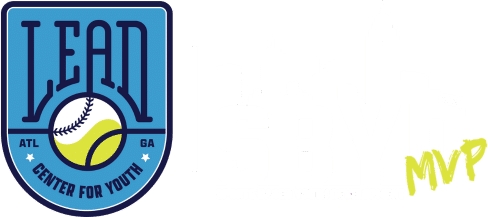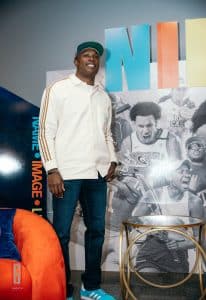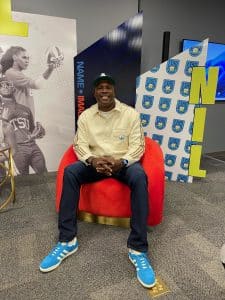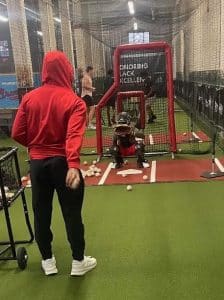
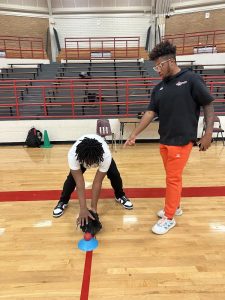
I have been developing elite baseball players for more than 25 years. My current and past players have received honors ranging from the “Gatorade High School Player of the Year,” the first pick in the Major League Baseball (MLB) draft, the “Dick Howser Trophy,” MLB “Rookie of the Year” and the MLB MVP, to name a few.
I owe my success to personal experience as an amateur, collegiate and professional baseball player, trusted mentors, a proven development process, devout study habits and the committed coaches I learn from and team with.
Two of the coaches I work with on a daily basis with L.E.A.D. Center For Youth are Tre’ Hampton and Andre Paris.
November through January is the time our coaching staff is committed to teaching our program participants grades 3 through 12th from Atlanta Public Schools how to practice, build habits and strength during our winter workouts.
They receive thousands of repetitions that we track to help us prepare them for February through April when they will convert their habits to skills.
Here are seven questions I recently asked Tre’ and Andre. Their answers will help you understand the heart of coaching Black boys in baseball:
Why did you choose to play baseball when you were younger?
Tre’: I did not choose baseball, it chose me in a way. I got introduced to it by one of my friends (who was playing) mother. She told my mom to sign me up so we could play on the same team. The rest was history as I fell in love with it. It was just fun to play and watch.
Andre: I chose to play baseball when I was younger because my mom signed me up after she noticed I really enjoyed hitting and watching the ball fly.
What’s the best way to get Black boys interested in baseball that have never played it before?
Tre’: Introducing it to them at a young age, but if that’s not an option the next best option is to approach them with it and play it.
Andre: I think the best way to get Black boys interested in baseball is by introducing the sport to them and allowing them to play in an environment where they are encouraged.
What are the top three things that can cause them to lose interest?
Tre’: No. 1 – Not being able to deal with failure. As we know, baseball has a lot of ups and downs and if a kid doesn’t have the mental capacity to deal with that then they will lose interest.
No. 2 – The lack of patience. Baseball players know there’s a game within the game going on at all times. But it doesn’t change the fact that in baseball, we stand around about 80% of the time. So boys who like quick fast-paced movement all the time like some other sports will cause them to lose interest.
No. 3 – Their environment. In the Black community baseball gets the short end of the stick compared to football and basketball. For whatever reason, the Black community has migrated to those two sports. So young black boys who are usually impressionable go for those sports because their environment tells them to.
Andre: I believe they are a lack of results, other sports that are more highly regarded pulling them away and their outside environment causing them to become distracted.
What are the top three things that a Black boy will learn from baseball that can help him become a good Black man?
Tre’: How to deal with adversity and overcome it. What hard work/discipline really is when it comes to the “real world.” How to work with a team/organization environment.
Andre: I believe that baseball will teach them patience, how to think ahead, and how to deal with adversity. I think these three things are critical because they all are necessary in dealing with the unexpected obstacles that appear in life.
What is unique about L.E.A.D.‘s approach to using baseball to develop Black boys on and off the field?
Tre’: The fact that we have Black coaches who can relate to their struggle. We can emphasize with them because we were them.
Andre: LEAD’s approach is unique because it allows young Black men such as myself to help develop the boys to become better players and people. I believe it’s important to do it this way because we are relatable to the environment they are growing up in.
What’s your favorite hitting drill?
Tre’: The Upper Half Load Drill.
Andre: My favorite hitting drill is the Top Hand Drill.
What’s your favorite defensive position to teach?
Tre’: That’s tough, but definitely anywhere on the infield for sure.
Andre: My favorite position to teach is catcher because I believe they are the glue to the team. Catchers have to manage game situations and be the eyes for all other eight positions. They are the only positions facing the opposite direction.
Henry “Hank” Aaron once said, “What you do with your life and how you do it is not only a reflection on you, but on your family and all of those institutions that have helped to make you who you are.”
Black boys are in good hands with strong Black men like Tre’ and Andre.
For more information, visit L.E.A.D. Center for Youth today.
If you found this inspiring and thought-provoking, or if you have any questions, comments or concerns, add me on Discord and let’s go deeper.
C.J. Stewart has built a reputation as one of the leading professional hitting instructors in the country. He is a former professional baseball player in the Chicago Cubs organization and has also served as an associate scout for the Cincinnati Reds. As founder and CEO of Diamond Directors Player Development, C.J. has more than 22 years of player development experience and has built an impressive list of clients, including some of the top young prospects in baseball today. If your desire is to change your game for the better, C.J. Stewart has a proven system of development and a track record of success that can work for you.
